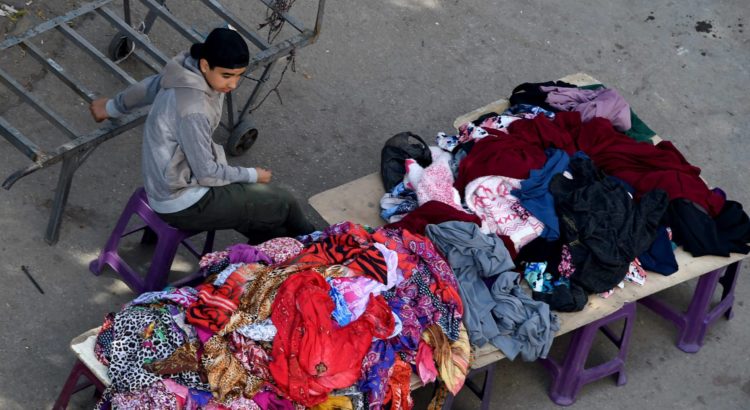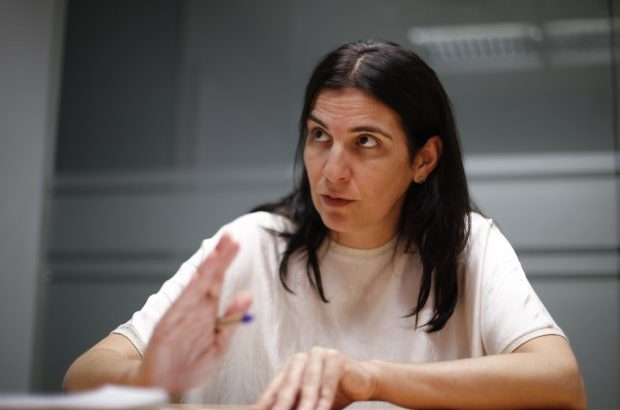English teacher Rebecca Bradley never thought her long Facebook post about cuts to school budgets and reforms in the curriculum would quickly make her a poster girl, but the candid post struck a chord among teachers and parents across Britain, collecting over 6,400 likes and thousands of comments.
In the Facebook note, the teacher of 12 years describes how rules for new GCSE exams are constantly changing, leaving both students and teachers at a loss. She also lists how the Tories’ grammar school program is diverting state funds to schools that will effectively benefit children from richer households.
However, what seemed to catch the public’s imagination were the severe cuts to school funding that has resulted in fewer teachers and teaching assistants, as well as fewer subjects and less pastoral support.
Do you have school-aged children?
I am a teacher. I’ve been a teacher for nearly twelve years. I’ve seen a huge number of education changes happen during this time, but I am worried about what is happening in education right now – and I am not sure that the general public are aware of the extent of the difficulties we face.
Let me start by saying that I am not concerned about my pay. I don’t want more money. I am not asking for your concern about my wages.
What I am concerned about are the cuts that the Conservative government are making to education – huge, life-changing cuts that are having a detrimental effect on the mental health and well-being of a massive number of children and young people.
This is going to be long, but if you have children, please bear with me and read to the end.
1. The new GCSE system
Michael Gove started his annihilation of the A*-G GCSE system back in 2010, and this year we see the first string of examinations take place. «More rigour» was the battle cry. However, did you know that the new GCSE English Literature exam – including the poetry exam, requiring study of an anthology of 15 poems – is closed-book? This means that no student will be given a copy of the text in their exam – not even SEND (special educational needs and disabilities) students, many of which have recall and memory problems.
The GCSE English Language exam uses extracts from heritage texts that carry a reading age of approximately 17. The average reading age of a GCSE-level student is 14. So why are we asking our students to read and analyse texts that are aimed at someone with a reading age 3 years above their own? Some of my students have a reading age of 9. They cannot in any way access the papers. In addition to this, the papers are up to 2hrs and 15mins long, often with a high number of questions – the Edexcel GCSE English Language paper 2 is equivalent to a mark a minute. I am seeing students who want to succeed breaking down as they simply cannot fit it all in – to understand and then interpret a text in such a small amount of time is extremely difficult for some students, and so what we are seeing is an increasing number of students switching off from their education as they simply write themselves off as ‘stupid’. You can see the Edexcel GCSE papers for English language here: https://qualifications.pearson.com/…/GCSE-English-Lang-SAMs…
I can only speak for English as it is my subject, but what I know is in existence across the whole curriculum is this: the Conservative government and Ofqual have released a new 9-1 grading system – but have only just, one month before GCSE exams commence, launched any real model of what each grade looks like. For the last two years, teachers have been working to help students achieve grades without knowing what those grades look like. We were told that a 9 was an «A**», reserved for the top 3% of the country, and we were told that a «good pass» would be a 5 and equivalent to a high C/low B, and that a 1 would be equivalent to a G, but that’s it. Last month, they even changed that – making the new «good pass» a 4 for students – but to add insult to injury, kept the «good pass» at a 5 for schools when being graded for league tables.
Confused yet? Imagine working in it.
We still don’t know how the new GCSEs are going to be graded. We probably won’t know for sure until after the exams. The Conservative government are talking about «rigour» whilst simultaneously asking us to teach a system that has such little «rigour» that nobody even knows what a student needs to do to achieve a 9 grade.
Schools are in disarray as they know one thing to be true – if their GCSE results are bad, Ofsted will swoop in, prepared to announce them as «requiring improvement». This will happen despite the fact that even though we have repeatedly asked for clearer guidance and clarification on exactly what we can do to help students achieve the best they can, we have not been given anything. Nothing at all.
The goalposts are *still* moving, even now – and some of your children are sitting these exams in less than a month.
We are risking entering a time where the Key Stage 4 curriculum consists of teaching to the test and not much else. This goes against everything that most teachers stand for. Teaching to the test is boring. It doesn’t help students to love their subjects; it kills any enthusiasm they ever had. Last week, I had a 90-minute discussion with my GCSE English group about whether Hyde (from Stevenson’s story) was really a person. It ended with the students asserting that Hyde was never a person; he was not even a personality – Hyde was simply an excuse. These GCSE students – aged 15 – critically evaluated the novel and its interpretations, deciding that Jekyll and Hyde is actually a story about choice, rather than split personalities or hidden evil. It was incredible. I walked away worried that I’d wasted an hour and a half of exam practice. This should not be happening.
2. Excessive Testing at Ages 7 and 11
I am going to give my professional opinion on this, as someone who works at the chalkface: these exams are completely arbitrary and do not test the skills required for success at GCSE and in adult life.
This year, I had a cohort of Year 7 students arrive at my school having not written a proper story for over a year. They knew what a fronted adverbial was, and how to spot an internal clause, and even what a preposition was – but when I set them a task to write a story, they broke down and cried. They cried. I asked them to write a story – something that should be incredibly enjoyable and an adventure, regardless of your level of ability or need – and they couldn’t do it. They knew the nuts and bolts, sure – but had no idea how to put them together in any meaningful way. They had ideas, but no confidence.
My year 7 cohort had some of the highest SATs scores we could have hoped for – many of them with scaled scores of 115 and higher (scaled scores go from 80-120, with 100 as an ‘average’), but their first creative writing piece was a huge failure, and I felt like a failure. We’ve since done a huge amount of work on story writing and creative motivation to develop their confidence and bring their marks up, but this has taken time from us that could have been used to develop their analytical skills, to develop their use of imagery and tone, to help them become more critical thinkers. I should not be teaching students how to piece a story together at secondary school.
I completely agree that students need to leave primary school ‘secondary ready’. However, I do not think that testing students’ ability to identify grammatical items over their ability to compose a creative piece is the best way to do it. It only increases student anxieties when they arrive at secondary school only to find that they have no idea how to approach their secondary-level subjects.
I have a firm belief that testing students does not make them better learners. What should be happening is this: teachers should be being given the freedom to develop their students’ motivation, creativity, critical thinking, enthusiasm and, most of all, their passion. Students with passion always, always succeed.
This Conservative government seem to think that «rigour» means taking education decisions out of the hands of teachers. Michael Gove – a journalist – started this course of action. He criticised us when we told him it would not work, and pressed ahead regardless.
Multiple studies have shown that the mental health of children is suffering under this government. This has been known as far back as 2015: http://www.independent.co.uk/…/over-focus-on-exams-causing-… with 90% of teachers agreeing that SATs preparation is harming students’ mental health: https://www.tes.com/…/nine-10-teachers-believe-sats-prepara…
3. Grammar Schools
We do not need grammar schools. We don’t. If we increase funding to all state schools to a level reflective of needs, allow teachers to develop a ‘grammar curriculum’ (lots of extra-curricular, increase independence of teachers), give schools ‘grammar resources and invest in better pastoral care (decent behaviour interventions that selective grammars don’t need) then we won’t need grammar schools. Don’t let Theresa May fool you.
The Conservative government say that working class students need a decent chance to succeed, and so she wants to build grammar schools above investing in local state-run facilities? Riiiiight. It’s a clear fact that house prices in catchment areas are higher. It’s a clear fact that middle-class families usually spend on tutoring and so more middle-class children get into grammar schools.
Why do we need to build more schools when we can just give more money to existing ones?
It’s easy to improve a school. Stop cutting funding and invest in decent support services. Which leads me to…
4. Cuts to Funding
When I entered teaching in 2005, most classes had a learning support assistant (you may know them as a TA). These people were incredibly important – they worked with SEND students, BESD (behavioural, social and emotional difficulties) students, assisted with students who had been absent or were having trouble accessing the curriculum and they did this on minimal pay, with minimal complaint. I once taught a class where two girls, twins, had complex SEND needs, spoke no English, could speak Arabic and German but couldn’t read it, and had no social skills. My TA was incredible, and she developed a whole scheme of picture-based activities for them to help them become happy, capable members of society.
This government have cut spending on education to the point where these TAs are rare, or simply don’t exist.
Now, teachers are asked to develop the progress and achievement of these students alone. If your child is dyslexic, they no longer have the ‘luxury’ of a TAs attention or time – instead, it is their teacher’s job to accommodate them. Believe me, this is something we want to do. If we had the ability, we’d break off a little bit of ourselves and sit with them as much as we could. However, the average class size is 30, and this is impossible. We are told we are failing when our most vulnerable students do not achieve, but when you have 30 students, it’s not always easy to give every vulnerable student the time you wish to give. TAs allowed every student to progress and achieve as they allowed the class teacher time to develop clear schemes of work that could be worked on separately to the class, alongside the main learning. Now, dyslexic students are at the hands of often newly-qualified teachers who are still developing their differentiation skills and do not always have the time or resources to make good things happen. This is a direct result of funding cuts.
This isn’t just about SEND students, either. The excessive cuts to education mean that many schools are now in a situation where they are considering making cuts in the curriculum and getting rid of specific subjects, usually the arts: http://www.independent.co.uk/…/education-schools-struggling…
Students today are being denied the opportunity to access the arts – the subjects that make them well-rounded thinkers, evaluative learners and creative, motivated individuals. I find it hard to stomach that due to excessive Conservative cuts, students are going to miss out on drama class, or art class, or music. That they may never know the joy of a school play, or what it feels like to be told to make their own song, or to find their groove when looking at characters in Shakespeare. Why the arts? Well, because they don’t add “rigour” – the new E-Bacc asks schools to focus on students getting English, maths, science, a language and a humanities subject – there is no requirement for arts. When you’re a cash-strapped school and you face a poor Ofsted report if your results are bad, why would you waste time and money on a qualification that, to the government, doesn’t count? These decisions are being made every damn day, because the government have headteachers over a barrel. You must succeed. You must get above average pass rates (which is in itself ridiculous; there will always be half below average). You must push out students with E-Baccs. If you don’t, we will academise you.
Are we here to provide exam factories that churn out identikit students? We’ve already seen a cut in vocational qualifications and a rise in mandatory GCSE resits in English and Maths. Therefore, if your daughter has her heart set on becoming a mechanic, she may not have the opportunity to even access a course until she is 18 – in the past, she could have done this at age 14, by choosing a vocational mechanic course as an ‘option’ – but hey-ho, these have been cut. Instead, she will have to do the same GCSEs as everyone else, and if she can’t get that “good pass” in English, well, then she’ll just have to resit. And if she doesn’t get the “good pass” the next time, well, she’ll just have to resit again. Until she is old enough to walk away. Why are we putting our students through this? Why aren’t we nurturing a child’s natural enthusiasm?
I taught a GCSE class back in 2009. It was a ‘bottom set’ class; they made my life hell but overall, were decent kids who just hated English, one of only two subjects they did at school as the rest of the time they were out doing vocational courses. They mainly got Ds in English, despite my best efforts. One own his own garage now. One runs her own hairdressing business. One builds motorbikes. One runs his own farm. Nowadays, these students wouldn’t stand a chance.
Cuts also affect the level of pastoral support that exists in schools. The best schools invest clearly in the wellbeing of their students by providing them with mentors, non-teaching year leaders, behaviour liaison officers and pastoral teams. Remember ‘Educating Essex’? Those ladies in the office who worked with the kids to get them back into class and enjoying education? Those are the important people. Those are the ones we are losing.
To end this massive rant, I want to point you towards the amazing-yet-horrifying website ‘School Cuts’ – www.schoolcuts.org.uk. It allows you to look at any school in the country and see the level of cuts, with a calculation of how many teachers it is equivalent to. I don’t think many people in the UK really understand what we are up against here. Here are a few figures that mean something to me:
Hove Park School, Brighton & Hove: -£940,335 in cuts – equivalent to 25 teachers or -£659 per pupil
The Burgess Hill Academy (formerly Oakmeeds Community College), Sussex: -£273,426 / 7 teachers / -£340 per pupil
Bridgemary Community School, Gosport: -£421,065 / 12 teachers / -£797 per pupil
Sir Thomas Boteler CofE High School, Warrington: -£132,685 / 4 teachers / -£211 per pupil
Durrington High School, Worthing: -£474,491 / 13 teachers / -£274 per pupil
This is horrifying. These cuts mean that your children are absolutely not getting the education they need or deserve – all thanks to apparently “unavoidable” cuts made by a government who have already cut corporation tax, can afford themselves an 11% pay rise, can reduce inheritance tax and make allowances for the very rich.
I know that you may not like the leaders of the other parties very much. I understand that Brexit plays a part. However, students are arriving to school hungry, and we no longer have the funds to provide for them. We are being forced by this government to pressure students through a horrific, class-led system that discriminates against anyone with educational needs and that none of us agree with – and changes to strike laws mean that we can’t even protest it the way we want to. Brexit is happening, for now. Don’t be blinded by May. She wants you to be blinkered and she wants you to ignore the massive demolition of education. Don’t give her what she wants.
A vote for the Conservative government is a vote that gives them a mandate to ruin the lives of young people today – unless Conservative voters work with us to stop these cuts. I urge you – please look at the schoolcuts website, please take in just how much is being cut from your local area and PLEASE look at the other parties’ policies on education. Challenge your Conservative MP. Ask them to fight for change too. This is an issue that does not need to be red or blue!
Teachers should control education. Not politicians.
If your school is striking this term, please understand that we never want to deprive anyone of education. Strikes are always a last resort and always happen when we are not being listened to. The media will try to spin it and tell you we are all selfish misers who want better pay. We don’t. We want an end to a broken and corrupt system that exploits children and benefits the rich – that is all. Support your local schools, help out where you can – and vote for a party who will bring the humanity back to education.
Support for her complaint was enthusiastic, with well-wishers from across the country leaving comments on the post.
Asked whether she thought it was the approaching general election that was motivating so many to share her message, Bradley said her political affiliation was of little consequence.
Last week, the National Union of Teachers backed calls for strikes in English schools against spending cuts.
The Department for Education replied to the threat by insisting that spending on schools is at its “highest level on record.”













 Users Today : 216
Users Today : 216 Total Users : 35404238
Total Users : 35404238 Views Today : 254
Views Today : 254 Total views : 3333733
Total views : 3333733